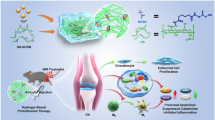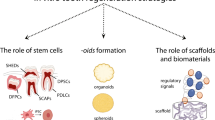Abstract
Hydroxyapatite nanoparticles (HA-NPs) are proposed for a miRNA delivery system with additional value in bone engineering because of its osteogenic activity. HA-NPs were synthesized by hydrothermal method, and surface-modified with two cationic functional groups 3-aminopropyltriethoxysilane (HA-NPs-APTES) and poly2-(dimethylamino)ethyl methacrylate (HA-NPs-PDMAEMA). The particles were visualized under a transmission electron microscope and then characterized for their physical properties, cell compatibility, and efficiency of miRNA binding. The FitC-tagged particles internalized in human mandibular osteoblasts (HMOBs) demonstrated insufficient miRNA binding and internalization of the unmodified particles. HA-NPs-APTES particles were in 150–200 nm elongated shape and demonstrated positive surface charge with the highest miRNA binding efficiency. HA-NPs-APTES was highly internalized in HMOBs without significantly changing cell metabolism. In contrast, PDMAEMA-modified particles demonstrated an increase in size and surface charge, and are thus potentially toxic to cells. The level of delivered miRNA in total RNA was determined by qPCR, and the HA-NP delivery system was analyzed. The HA-NP delivery system efficiently delivered miRNA, and the miRNA-targeted GAPDH expression was diminished by three- to tenfold. The GAPDH level was suppressed after 50 μg/mL or 100 μg/mL HA-NPs-APTES, significantly lower than the effect by Dharmafect. In conclusion, HA-NPs-APTES demonstrates optimal efficiency in miRNA delivery and gene regulation in the osteoblast in vitro model.




Similar content being viewed by others
Data availability
The datasets generated during and/or analyzed during the current study are available from the corresponding author on reasonable request.
References
Bai H, Lester GMS, Petishnok LC, Dean DA (2017) Cytoplasmic transport and nuclear import of plasmid DNA. Biosci Rep 37. https://doi.org/10.1042/BSR20160616
Barradas AMC, Yuan H, van Blitterswijk CA, Habibovic P (2011) Osteoinductive biomaterials: current knowledge of properties, experimental models and biological mechanisms. Eur Cell Mater 21:407–429; discussion 429. https://doi.org/10.22203/ecm.v021a31
Cai Q, Zhu Y, He JQ, Wang ZH, Su F, Xu FJ, Yang XP, Yang WT (2012) Well-defined hydroxyapatite–polycation nanohybrids via surface-initiated atom transfer radical polymerization for biomedical applications. J Mater Chem 22:9358–9367. https://doi.org/10.1039/c2jm31109g
Chen Y, Gao D-Y, Huang L (2015) In vivo delivery of miRNAs for cancer therapy: challenges and strategies. Adv Drug Deliv Rev 81:128–141. https://doi.org/10.1016/j.addr.2014.05.009
Cheng CJ, Bahal R, Babar IA, Pincus Z, Barrera F, Liu C, Svoronos A, Braddock DT, Glazer PM, Engelman DM, Saltzman WM, Slack FJ (2015) MicroRNA silencing for cancer therapy targeted to the tumour microenvironment. Nature 518(7537):107–110
Fabbri M, Paone A, Calore F, Galli R, Croce CM (2013) A new role for microRNAs, as ligands of toll-like receptors. RNA Biol 10:169–174. https://doi.org/10.4161/rna.23144
Fröhlich E (2012) The role of surface charge in cellular uptake and cytotoxicity of medical nanoparticles. Int J Nanomedicine 7:5577–5591. https://doi.org/10.2147/IJN.S36111
Gilleron J, Querbes W, Zeigerer A, Borodovsky A, Marsico G, Schubert U, Manygoats K, Seifert S, Andree C, Stöter M, Epstein-Barash H, Zhang L, Koteliansky V, Fitzgerald K, Fava E, Bickle M, Kalaidzidis Y, Akinc A, Maier M, Zerial M (2013) Image-based analysis of lipid nanoparticle-mediated siRNA delivery, intracellular trafficking and endosomal escape. Nat Biotechnol 31:638–646. https://doi.org/10.1038/nbt.2612
Glinge C, Clauss S, Boddum K, Jabbari R, Jabbari J, Risgaard B, Tomsits P, Hildebrand B, Kääb S, Wakili R, Jespersen T, Tfelt-Hansen J (2017) Stability of circulating blood-based MicroRNAs - pre-analytic methodological considerations. PLoS One 12:e0167969. https://doi.org/10.1371/journal.pone.0167969
Granot Y, Peer D (2017) Delivering the right message: challenges and opportunities in lipid nanoparticles-mediated modified mRNA therapeutics-an innate immune system standpoint. Semin Immunol 34:68–77. https://doi.org/10.1016/j.smim.2017.08.015
Hadas Y, Sultana N, Youssef E, Sharkar MTK, Kaur K, Chepurko E, Zangi L (2019) Optimizing modified mRNA in vitro synthesis protocol for heart gene therapy. Mol Ther Methods Clin Dev 14:300–305. https://doi.org/10.1016/j.omtm.2019.07.006
Huntzinger E, Izaurralde E (2011) Gene silencing by microRNAs: contributions of translational repression and mRNA decay. Nat Rev Genet 12:99–110
Irwandi RA, Khonsuphap P, Limlawan P, Vacharaksa A (2018) miR-302a-3p regulates RANKL expression in human mandibular osteoblast-like cells. J Cell Biochem 119:4372–4381. https://doi.org/10.1002/jcb.26456
Kapadia CH, Ioele SA, Day ES (2020a) Layer-by-layer assembled PLGA nanoparticles carrying miR-34a cargo inhibit the proliferation and cell cycle progression of triple-negative breast cancer cells. J Biomed Mater Res A 108:601–613. https://doi.org/10.1002/jbm.a.36840
Kapadia CH, Luo B, Dang MN, Irvin-Choy ND, Valcourt DM, Day ES (2020b) Polymer nanocarriers for MicroRNA delivery. J Appl Polym Sci 25:48651. https://doi.org/10.1002/app.48651
Kim TK, Eberwine JH (2010) Mammalian cell transfection: the present and the future. Anal Bioanal Chem 397:3173–3178. https://doi.org/10.1007/s00216-010-3821-6
Kimura T, Nibe Y, Funamoto S, Okada M, Furuzono T, Ono T, Yoshizawa H, Fujisato T, Nam K, Kishida A (2011) Preparation of a nanoscaled poly(vinyl alcohol)/hydroxyapatite/DNA complex using high hydrostatic pressure technology for in vitro and in vivo gene delivery. J Drug Deliv 2011:962743–962748. https://doi.org/10.1155/2011/962743
Köberle V, Pleli T, Schmithals C, Augusto Alonso E, Haupenthal J, Bönig H, Peveling-Oberhag J, Biondi RM, Zeuzem S, Kronenberger B, Waidmann O, Piiper A (2013) Differential stability of cell-free circulating microRNAs: implications for their utilization as biomarkers. PLoS One 8:e75184. https://doi.org/10.1371/journal.pone.0075184
Künnapuu K, Veiman K-L, Porosk L, Rammul E, Kiisholts K, Langel Ü, Kurrikoff K (2019) Tumor gene therapy by systemic delivery of plasmid DNA with cell-penetrating peptides. FASEB Bioadv 1:105–114. https://doi.org/10.1096/fba.1026
Li J, Xue S, Mao Z-W (2016) Nanoparticle delivery systems for siRNA-based therapeutics. J Mater Chem B 4:6620–6639. https://doi.org/10.1039/C6TB01462C
Ma D (2014) Enhancing endosomal escape for nanoparticle mediated siRNA delivery. Nanoscale 6:6415–6425. https://doi.org/10.1039/c4nr00018h
Mencía Castaño I, Curtin CM, Shaw G et al (2015) A novel collagen-nanohydroxyapatite microRNA-activated scaffold for tissue engineering applications capable of efficient delivery of both miR-mimics and antagomiRs to human mesenchymal stem cells. J Control Release 200:42–51. https://doi.org/10.1016/j.jconrel.2014.12.034
Muthiah M, Park I-K, Cho C-S (2013) Nanoparticle-mediated delivery of therapeutic genes: focus on miRNA therapeutics. Expert Opin Drug Deliv 10:1259–1273. https://doi.org/10.1517/17425247.2013.798640
Okazaki M, Yoshida Y, Yamaguchi S, Kaneno M, Elliott JC (2001) Affinity binding phenomena of DNA onto apatite crystals. Biomaterials 22:2459–2464. https://doi.org/10.1016/s0142-9612(00)00433-6
Peng L-H, Niu J, Zhang C-Z, Yu W, Wu JH, Shan YH, Wang XR, Shen YQ, Mao ZW, Liang WQ, Gao JQ (2014) TAT conjugated cationic noble metal nanoparticles for gene delivery to epidermal stem cells. Biomaterials 35:5605–5618. https://doi.org/10.1016/j.biomaterials.2014.03.062
Rather HA, Jhala D, Vasita R (2019) Dual functional approaches for osteogenesis coupled angiogenesis in bone tissue engineering. Mater Sci Eng C Mater Biol Appl 103:109761. https://doi.org/10.1016/j.msec.2019.109761
Rupaimoole R, Slack FJ (2017) MicroRNA therapeutics: towards a new era for the management of cancer and other diseases. Nat Rev Drug Discov 16:203–222. https://doi.org/10.1038/nrd.2016.246
Russo L, Taraballi F, Lupo C, Poveda A, Jiménez-Barbero J, Sandri M, Tampieri A, Nicotra F, Cipolla L (2014) Carbonate hydroxyapatite functionalization: a comparative study towards (bio)molecules fixation. Interface Focus 4:20130040. https://doi.org/10.1098/rsfs.2013.0040
Sahin U, Karikó K, Türeci Ö (2014) mRNA-based therapeutics--developing a new class of drugs. Nat Rev Drug Discov 13:759–780. https://doi.org/10.1038/nrd4278
Scholz C, Wagner E (2012) Therapeutic plasmid DNA versus siRNA delivery: common and different tasks for synthetic carriers. J Control Release 161:554–565. https://doi.org/10.1016/j.jconrel.2011.11.014
Shirley JL, de Jong YP, Terhorst C, Herzog RW (2020) Immune responses to viral gene therapy vectors. Mol Ther 28:709–722. https://doi.org/10.1016/j.ymthe.2020.01.001
Sun J, Zheng X, Li H, Fan D, Song Z, Ma H, Hua X, Hui J (2017) Monodisperse selenium-substituted hydroxyapatite: controllable synthesis and biocompatibility. Mater Sci Eng C Mater Biol Appl 73:596–602. https://doi.org/10.1016/j.msec.2016.12.106
Tseng Y-C, Mozumdar S, Huang L (2009) Lipid-based systemic delivery of siRNA. Adv Drug Deliv Rev 61:721–731. https://doi.org/10.1016/j.addr.2009.03.003
Uskoković V, Uskoković DP (2011) Nanosized hydroxyapatite and other calcium phosphates: chemistry of formation and application as drug and gene delivery agents. J Biomed Mater Res Part B Appl Biomater 96:152–191. https://doi.org/10.1002/jbm.b.31746
Varkouhi AK, Scholte M, Storm G, Haisma HJ (2011) Endosomal escape pathways for delivery of biologicals. J Control Release 151:220–228. https://doi.org/10.1016/j.jconrel.2010.11.004
Wang L, Zhang L (2020) Circulating exosomal miRNA as diagnostic biomarkers of neurodegenerative diseases. Front Mol Neurosci 13:53. https://doi.org/10.3389/fnmol.2020.00053
Wang X, Li X, Ito A, Watanabe Y, Tsuji NM (2016a) Rod-shaped and fluorine-substituted hydroxyapatite free of molecular immunopotentiators stimulates anti-cancer immunity in vivo. Chem Commun (Camb) 52:7078–7081. https://doi.org/10.1039/c6cc02848a
Wang X, Li X, Ito A, Watanabe Y, Sogo Y, Hirose M, Ohno T, Tsuji NM (2016b) Rod-shaped and substituted hydroxyapatite nanoparticles stimulating type 1 and 2 cytokine secretion. Colloids Surf B: Biointerfaces 139:10–16. https://doi.org/10.1016/j.colsurfb.2015.12.004
Yamamoto A, Kormann M, Rosenecker J, Rudolph C (2009) Current prospects for mRNA gene delivery. Eur J Pharm Biopharm 71:484–489. https://doi.org/10.1016/j.ejpb.2008.09.016
Yang N (2015) An overview of viral and nonviral delivery systems for microRNA. Int J Pharm Investig 5:179–181. https://doi.org/10.4103/2230-973X.167646
Zhang Y, Wang Z, Gemeinhart RA (2013) Progress in microRNA delivery. J Control Release 172:962–974. https://doi.org/10.1016/j.jconrel.2013.09.015
Zhao L, Zhao W, Liu Y et al (2017) Nano-hydroxyapatite-derived drug and gene co-delivery system for anti-angiogenesis therapy of breast Cancer. Med Sci Monit 23:4723–4732. https://doi.org/10.12659/msm.902538
Acknowledgments
We would like to thank Assoc. Prof. Anak Khantachawana and Assoc. Prof. Kwanchanok Pasuwat for providing access to live cell time-lapse microscopy at the Automated Tissue Culture Lab, King Mongkut’s University of Technology Thonburi (Bangkhuntian). This research is funded by Royal Golden Jubilee Ph.D. scholarship from the Thailand Research Fund and Faculty of Dentistry Research Fund, Chulalongkorn University (DRT 61020). N. Thepphanao received financial support from Graduate School Thesis Grant, Chulalongkorn University, and Center of Excellence on Petrochemical and Materials Technology.
Funding
This research is funded by Royal Golden Jubilee Ph.D. scholarship from the Thailand Research Fund and the research fund by the Faculty of Dentistry, Chulalongkorn University (DRT 61020). N. Thepphanao received financial support from Graduate School Thesis Grant, Chulalongkorn University, and Center of Excellence on Petrochemical and Materials Technology.
Author information
Authors and Affiliations
Contributions
1. Study conception and design:
Pirawish Limlawan, Anjalee Vacharaksa
2. Acquisition of data:
Pirawish Limlawan, Nathaya Thepphanao
3. Analysis and interpretation of data:
Pirawish Limlawan, Nathaya Thepphanao, Numpon Insin, Anjalee Vacharaksa
4. Drafting of manuscript:
Pirawish Limlawan, Nathaya Thepphanao, Anjalee Vacharaksa
5. Critical revision:
Pirawish Limlawan, Numpon Insin, Anjalee Vacharaksa
Corresponding author
Ethics declarations
Conflict of interest
The authors declare that they have no conflict of interest.
Ethics approval
The use of human cells in this study is authorized by the Ethics Committee of the Faculty of Dentistry, Chulalongkorn University (HREC-DCU 2019-023).
Consent to participate
Informed consent for a patient’s bone tissue was given to the patient before mandibular tooth impaction surgery with approval of the ethics committee.
Consent for publication
Not applicable
Code availability
Not applicable
Additional information
Publisher’s note
Springer Nature remains neutral with regard to jurisdictional claims in published maps and institutional affiliations.
Supplementary information
Supplemental Fig. 1
. Flow Cytometry plotting of FitC-positive HmOBs. Cells were incubated (24 h) with various concentration (20, 50, 100 μg/mL) of (a) FitC-tag HA-NPs, (b) APTES-modified (HA-NPs-APTES), (c) PDMAEMA-modified (HA-NPs-PDMAEMA) particles. The cells incubated with particles without FitC are included in the control. The total number of gated cells is approximately 10,000. The control cells are shown to demonstrate FigC-negative cells. The number of FitC-positive cells is determined from the cell population above the cut point line that is distinct from the control group. (PNG 2957 kb)
ESM 1
(DOCX 9 kb)
ESM 2
(WMV 2757 kb)
ESM 3
(WMV 1597 kb)
Rights and permissions
About this article
Cite this article
Limlawan, P., Thepphanao, N., Insin, N. et al. Surface-modified hydroxyapatite nanoparticle for microRNA delivery to regulate gene expression in human mandibular osteoblast cells. J Nanopart Res 23, 12 (2021). https://doi.org/10.1007/s11051-020-05121-0
Received:
Accepted:
Published:
DOI: https://doi.org/10.1007/s11051-020-05121-0




